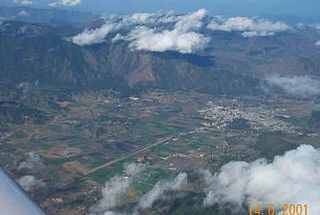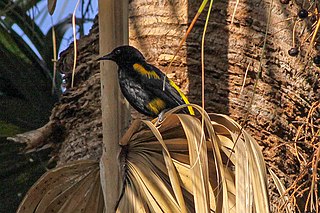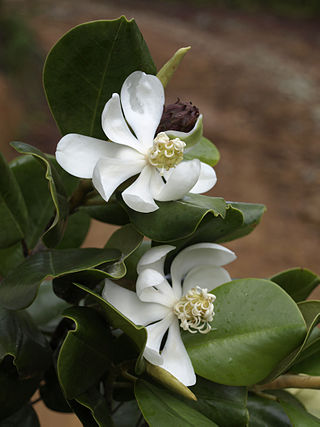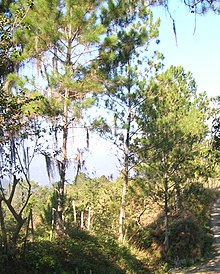
Hispaniola is an island in the Caribbean that is part of the Greater Antilles. Hispaniola is the most populous island in the West Indies, and the region's second largest in area, after the island of Cuba. The 76,192-square-kilometre (29,418 sq mi) island is divided into two separate nations: the Spanish-speaking Dominican Republic to the east and the French/Haitian Creole-speaking Haiti to the west. The only other divided island in the Caribbean is Saint Martin, which is shared between France and the Netherlands.

Pico Duarte is the highest peak in the Dominican Republic, on the island of Hispaniola and in all the Caribbean. At 3,101 m (10,174 ft) above sea level, it gives Hispaniola the 16th-highest maximum elevation of any island in the world. Additionally, it is only 85 kilometres northeast of the region's lowest point, Lake Enriquillo, 46 m below sea level. It is part of the Cordillera Central range, which extends from the plains between San Cristóbal and Baní to the northwestern peninsula of Haiti, where it is known as the Massif du Nord. The highest elevations of the Cordillera Central are found in the Pico Duarte and Valle Nuevo massifs.

The Hispaniolan palm crow is a relatively small corvid is endemic to the Caribbean island of Hispaniola where it was formerly very frequent, but is now reduced in population.

The Hispaniolan pine forests are a subtropical coniferous forest ecoregion found on the Caribbean island of Hispaniola, which is shared by Haiti and the Dominican Republic. The ecoregion covers 11,600 km2 (4,500 sq mi), or about 15% of the island. It lies at elevations greater than 800 m (2,600 ft) in the mountains of Hispaniola, extending from the Cordillera Central of the Dominican Republic and into the Massif du Nord of Haiti. It is surrounded at lower elevations by the Hispaniolan moist forests and Hispaniolan dry forests ecoregions, which cover the remainder of the island. Annual rainfall is 1,000–2,000 mm (39–79 in).

The Hispaniolan crossbill is a crossbill that is endemic to the island of Hispaniola, and the only representative of the Loxia genus in the Caribbean.

La Visite National Park is one of the two largest national parks of the Republic of Haiti. La Visite is a part of the Massif de la Selle mountain range. Its highest peak is 2275 meters in elevation. The park covers approximately 11,419 hectares of land with 1897 hectares above 2000 meters in elevation, and consists mainly of pine forest, grasslands, and some montane broadleaf forest above 1,700 m (5,600 ft) elevation. The Haitian government established the La Visite National Park in 1983. The capital, Port-au-Prince, is only 22 kilometers north from the park. The northern boundary of La Visite National Park is the east-west running escarpment of the Massif de la Selle.

The Hispaniolan solenodon, also known as the agouta, is a small, furry, shrew-like mammal endemic to the Caribbean island of Hispaniola. Like other solenodons, it is a venomous, insect-eating animal that lives in burrows and is active at night. It is an elusive animal and was only first described in 1833; its numbers are stable in protected forests but it remains the focus of conservation efforts.

Pinus cubensis, or Cuban pine, is a pine endemic to the eastern highlands of the island of Cuba, inhabiting both the Sierra Nipe-Cristal and Sierra Maestra mountain ranges.

Constanza is a town and municipality in La Vega Province, Dominican Republic. Located in the Cordillera Central region, Constanza is known for having the coldest temperature for a settlement on the island of Hispaniola, as well as the entire Caribbean.

The golden swallow is a swallow endemic to the Caribbean island of Hispaniola and was once native to Jamaica, but is now extirpated there. It is restricted to isolated montane forests that primarily consist of the Hispaniolan pine. This species is considered to be a vulnerable species by the International Union for Conservation of Nature (IUCN). The exact cause of its extirpation from Jamaica is unknown, but likely factors include predation by introduced mammals and habitat loss, although the habitat loss theory is not supported by much evidence. The last sighting of the nominate subspecies was in Hardwar Gap, with three birds being seen on 8 June 1989.
Podocarpus coriaceus, commonly known as the yucca plum pine, is a species of conifer, an evergreen tree in the family Podocarpaceae. It is found in the Dominican Republic, Guadeloupe, Martinique, Montserrat, Puerto Rico, and Saint Kitts and Nevis.

The Hispaniolan common tree frog, Hispaniolan laughing tree frog, or Dominican tree frog, is a species of frog in the family Hylidae endemic to the island of Hispaniola.

The southern pastel frog or Hispaniola robber frog is a species of frog in the family Eleutherodactylidae. It is endemic to Hispaniola and known from the Massif de la Selle, both in the Dominican Republic and in Haiti. Its natural habitats are upland pine forests. Males call from the ground. It is threatened by habitat loss caused by logging and agriculture. It is known from the Sierra de Bahoruco National Park, but habitat degradation is occurring in this area too.

The Hispaniolan nightjar is a nightjar species endemic to the Caribbean island of Hispaniola, which is shared by the Dominican Republic and Haiti.

The Hispaniolan parakeet is a Vulnerable species of bird in subfamily Arinae of the family Psittacidae, the African and New World parrots. It is endemic to the island of Hispaniola which is shared by the Dominican Republic and Haiti. In the former country it is called "perico" and in the latter "perruche".

The Antillean piculet is a species of bird in subfamily Picinae of the woodpecker family Picidae. It is endemic to the Caribbean island of Hispaniola that is shared by the Dominican Republic and Haiti.

The Hispaniolan trogon is a species of bird in the family Trogonidae. It is endemic to Hispaniola in the Caribbean. It is one of the only two trogon species found in the Caribbean. It is the national bird of Haiti.

The Hispaniolan oriole is a species of bird in the family Icteridae. It is endemic to the Caribbean island of Hispaniola.

José Armando Bermúdez National Park is a Dominican Republic National Park spanning the northern slopes and central portions of the Central Mountain Range.

The Ebano Verde Scientific Reserve in the Dominican Republic was created on October 26, 1989 by Decree No. 417-89, Environment and Resources General Law 64-00, ratified by the Protected Areas Sectorial Law No. 202-04, ordered by then President Joaquin Balaguer.



















